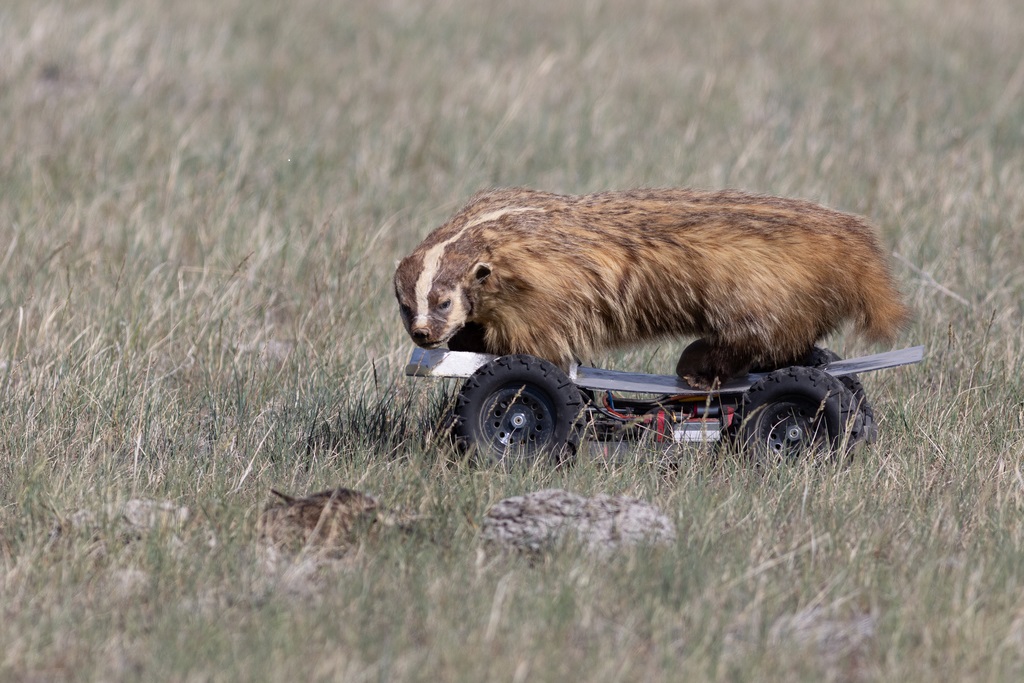
Wild black-tailed prairie dogs use alarm calls to warn one another of predators, and some grassland birds are listening in. Photo credit: Andrew Dreelin, Smithsonian’s National Zoo and Conservation Biology Institute.
With distinct alarm calls and yips, black-tailed prairie dogs are a highly social and communicative icon of the Great Plains. A new study published today in Animal Behaviour suggests other species may benefit from all their chatter, too. Researchers from the Smithsonian’s National Zoo and Conservation Biology Institute (NZCBI) discovered that long-billed curlews eavesdrop on black-tailed prairie dog alarm calls and adjust their anti-predator behaviors accordingly. This finding may be key to understanding why curlews choose to nest near prairie dog colonies, despite them being magnets for predators.
Prairie dogs live in large, social groups called colonies or ‘towns’ in short-grass habitats throughout the Great Plains of North America. On prairie dog towns, threats from predators can come from all angles—hawks and eagles from the sky and foxes, snakes and badgers on the ground. As a result, prairie dogs developed distinct alarm calls containing detailed information, such as whether a predator is terrestrial or aerial and even the predator’s color. This flow of information allows the colony to react faster to threats, increasing overall fitness within the population. Andrew Dreelin, the lead author of the study and a doctoral fellow with NZCBI’s Migratory Bird Center and Great Plains Science Program, wondered whether other species could tap into this flow of information, too.
“Lots of birds live on or around prairie dog towns even though they are magnets for predators, so we suspected birds would have ways to mitigate that risk to better enjoy the benefits,” Dreelin, who is also a doctoral candidate at Northern Illinois University, said. “While the scientific community is aware of a variety of habitat-based advantages, such as maintaining grasslands by removing woody shrubs, with this study, we are getting to see an underappreciated behavioral benefit. This brings us one step closer to understanding the complex relationship between prairie dogs and grassland birds.”
To determine whether curlews were listening in on their prairie dog neighbors, Dreelin’s team attached a taxidermy American badger to a radio-controlled car (the so-called “Badger-inator”) to simulate a common predator of both species. The team recorded prairie dogs’ alarm calls and later played the recordings to nesting curlews while driving the badger toward the nests. The researchers found that when faced with the badger, incubating female curlews would flatten themselves over their nests, effectively disappearing into the grass. Most importantly, incubating females adopted defensive positions sooner when the prairie dog alarm calls were played to them, while the badger was significantly further away from the nest. Had it been a real predator, the curlews’ early response could have meant the difference between life and death.
Interestingly, non-incubating male curlews did not appear to heed the prairie dogs’ warnings. Like prairie dogs, long-billed curlews make alarm calls, but rather than flee, they will often mob the offending predator to dissuade it. But researchers found non-incubating curlews were just as likely to sound the alarm and mob the Badger-inator with or without prairie dog alarm calls. This could be because a conspicuous response could attract more attention, leading to higher nest predation. Interspecific communication appears to be a hidden but important new way in which prairie dogs are interacting with other grassland species, according to Andy Boyce, NZCBI ecologist and senior author of the study.
“We know that prairie dogs are keystone species because of the way they physically alter the environment and create homes for other plants and animals,” Boyce said. “What we hadn’t realized until now is that in addition to being homebuilders, they might also be acting as home-security systems.”
There is still much to learn about inter-species communication, including whether eavesdropping on prairie dog calls is common among all grassland birds, and whether this eavesdropping actually improves survival rates of nests and adult birds. But researchers say these findings, combined with the prior instance of burrowing owls responding to prairie dog vocalizations, serves as evidence of prairie dogs being keystone information producers, as well as ecosystem engineers.
“As we look to protect grassland birds, like the long-billed curlew, it’s critical to understand everything that impacts their survival,” Boyce said. “This study demonstrates that prairie dogs may directly influence the reproductive success of grassland birds and should be considered important parts of any conservation plans.”
Smithsonian’s National Zoo and Conservation Biology Institute (NZCBI)
NZCBI leads the Smithsonian’s global effort to save species, better understand ecosystems and train future generations of conservationists. Its two campuses are home to more than 2,100 animals, including some of the world’s most critically endangered species. Always free of charge, the Zoo’s 163-acre park in the heart of Washington, D.C., features 2,100 animals representing 400 species and is a popular destination for children and families. At the Conservation Biology Institute’s 3,200-acre campus in Virginia, breeding and veterinary research on 250 animals representing 20 species provide critical data for the management of animals in human care and valuable insights for conservation of wild populations. NZCBI’s 305 staff and scientists work in Washington, D.C., Virginia and with partners at field sites across the United States and in more than 30 countries to save wildlife, collaborate with communities and conserve native habitats. NZCBI is a long-standing accredited member of the Association of Zoos and Aquariums.
# # #
SI-100-2025
Annalisa Meyer
202-633-3081
Ellie Tahmaseb
202-843-2958
Photos and b-roll are available in the Zoo’s newsroom.
